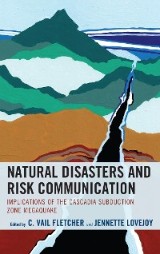Details

Natural Disasters and Risk Communication
Implications of the Cascadia Subduction Zone MegaquakeEnvironmental Communication and Nature: Conflict and Ecoculture in the Anthropocene
|
109,99 € |
|
| Verlag: | Lexington Books |
| Format: | EPUB |
| Veröffentl.: | 23.05.2018 |
| ISBN/EAN: | 9781498556125 |
| Sprache: | englisch |
| Anzahl Seiten: | 278 |
DRM-geschütztes eBook, Sie benötigen z.B. Adobe Digital Editions und eine Adobe ID zum Lesen.
Beschreibungen
<span><span>Natural Disasters and Risk Communication: Implications of the Cascadia Subduction Zone Megaquake</span><span> asks and addresses how we communicate about natural disasters and what effect our communication has on natural disaster education, understanding, assessment of risk, preparation, and recovery. The chapters of this book present expertise, analyses, and perspectives that are designed to help us better comprehend and deal with the natural risks such as the Cascadia Subduction Zone. It seeks to move past primal, fear-induced physiological and emotional responses to crises with the understanding that if we accept that the disaster will occur, expect it, and learn how we can prepare, we can calm the collective panicked beats of our hearts as we wait for its first tremors.</span></span>
<span><span>This book examines the impending Cascadia Subduction Zone earthquake and tsunami from a communications perspective, using similar experiences of natural disaster preparedness and outcomes as case studies. It is an interdisciplinary consideration of how communities communicate and make sense of natural disasters. </span></span>
<span><span>Acknowledgements</span></span>
<br>
<span><span>Foreword</span></span>
<br>
<span><span>Kathryn Schulz</span></span>
<br>
<span><span>1. Introduction </span></span>
<br>
<span><span>Conceptualizing Risk: Media Coverage and Natural Disasters</span></span>
<br>
<span><span>Jennette Lovejoy</span></span>
<br>
<br>
<span><span>Part 1: Cascadia Subduction Zone: Geological Background and Predicting Preparedness in the Pacific Northwest</span></span>
<br>
<br>
<span><span>2. Cascadia Earthquake Science and Hazards</span></span>
<br>
<span><span>Robert F. Butler</span></span>
<br>
<span><span>3. Risk Perception and Earthquake Preparedness Motivation: Predicting Responses to a Cascadia Subduction Zone Catastrophic Event</span></span>
<br>
<span><span>Bradley Adame and Claude Miller</span></span>
<br>
<br>
<span><span>Part 2: Confronting Risk Information: Rhetorical Framing in the Media and Stages of Crisis </span></span>
<br>
<br>
<span><span>4. The article that shook the public: A comparative study of “The Really Big One” and other earthquake news coverage</span></span>
<br>
<span><span>Julie Homchick Crowe</span></span>
<br>
<span><span>5. A “Fast and Frugal” Approach to Risk Judgment and Decision-Making and its Implications for Natural Disaster</span></span>
<br>
<span><span>Kai Kuang</span></span>
<br>
<br>
<span><span>Part 3: Local and Global Case Studies: Analyzing Demographic, Attitude and Economic Factors in Natural Disasters </span></span>
<br>
<br>
<span><span>6. Public risk perception attitudes on flooding by different societal sectors: An investigation based on the August 2016 flood in Louisiana</span></span>
<br>
<span><span>Do Kyun Kim and Phillip Madison</span></span>
<br>
<span><span>7. Economic Evaluation of Multi-Hazard Risk Information in Japan: Implication for Earthquake Risk Communication</span></span>
<br>
<span><span>Hiroaki Matsuura and Keiichi Sato</span></span>
<br>
<br>
<span><span>Part 4: Community, Organizing, and Resilience: Pragmatic Considerations</span></span>
<br>
<br>
<span><span>8. Families, Companion Animals, and the CSZ Disaster: Implications for Crisis and Risk Communication</span></span>
<br>
<span><span>Julie M. Novak and Ashleigh Day</span></span>
<br>
<span><span>9. What is to be Done?—A Preparedness Polemic</span></span>
<br>
<span><span>Yianni Doulis</span></span>
<br>
<span><span>10. Nature, Fear, and Bewilderment: An Anthropcenic (Dis)Connect </span></span>
<br>
<span><span>C. Vail Fletcher</span></span>
<br>
<br>
<span><span>Epilogue</span></span>
<br>
<span><span>Chris Goldfinger</span></span>
<br>
<br>
<span><span>Index</span></span>
<br>
<span><span>About the Contributors</span></span>
<br>
<span><span>Foreword</span></span>
<br>
<span><span>Kathryn Schulz</span></span>
<br>
<span><span>1. Introduction </span></span>
<br>
<span><span>Conceptualizing Risk: Media Coverage and Natural Disasters</span></span>
<br>
<span><span>Jennette Lovejoy</span></span>
<br>
<br>
<span><span>Part 1: Cascadia Subduction Zone: Geological Background and Predicting Preparedness in the Pacific Northwest</span></span>
<br>
<br>
<span><span>2. Cascadia Earthquake Science and Hazards</span></span>
<br>
<span><span>Robert F. Butler</span></span>
<br>
<span><span>3. Risk Perception and Earthquake Preparedness Motivation: Predicting Responses to a Cascadia Subduction Zone Catastrophic Event</span></span>
<br>
<span><span>Bradley Adame and Claude Miller</span></span>
<br>
<br>
<span><span>Part 2: Confronting Risk Information: Rhetorical Framing in the Media and Stages of Crisis </span></span>
<br>
<br>
<span><span>4. The article that shook the public: A comparative study of “The Really Big One” and other earthquake news coverage</span></span>
<br>
<span><span>Julie Homchick Crowe</span></span>
<br>
<span><span>5. A “Fast and Frugal” Approach to Risk Judgment and Decision-Making and its Implications for Natural Disaster</span></span>
<br>
<span><span>Kai Kuang</span></span>
<br>
<br>
<span><span>Part 3: Local and Global Case Studies: Analyzing Demographic, Attitude and Economic Factors in Natural Disasters </span></span>
<br>
<br>
<span><span>6. Public risk perception attitudes on flooding by different societal sectors: An investigation based on the August 2016 flood in Louisiana</span></span>
<br>
<span><span>Do Kyun Kim and Phillip Madison</span></span>
<br>
<span><span>7. Economic Evaluation of Multi-Hazard Risk Information in Japan: Implication for Earthquake Risk Communication</span></span>
<br>
<span><span>Hiroaki Matsuura and Keiichi Sato</span></span>
<br>
<br>
<span><span>Part 4: Community, Organizing, and Resilience: Pragmatic Considerations</span></span>
<br>
<br>
<span><span>8. Families, Companion Animals, and the CSZ Disaster: Implications for Crisis and Risk Communication</span></span>
<br>
<span><span>Julie M. Novak and Ashleigh Day</span></span>
<br>
<span><span>9. What is to be Done?—A Preparedness Polemic</span></span>
<br>
<span><span>Yianni Doulis</span></span>
<br>
<span><span>10. Nature, Fear, and Bewilderment: An Anthropcenic (Dis)Connect </span></span>
<br>
<span><span>C. Vail Fletcher</span></span>
<br>
<br>
<span><span>Epilogue</span></span>
<br>
<span><span>Chris Goldfinger</span></span>
<br>
<br>
<span><span>Index</span></span>
<br>
<span><span>About the Contributors</span></span>
<span><span>C. Vail Fletcher</span><span> is associate professor in the Department of Communication at the University of Portland.</span></span>
<br>
<br>
<span><span>Jennette Lovejoy</span><span> is associate professor in the Department of Communication at the University of Portland. </span></span>
<br>
<br>
<span><span>Jennette Lovejoy</span><span> is associate professor in the Department of Communication at the University of Portland. </span></span>
Diese Produkte könnten Sie auch interessieren:

Topos Österreich | Topos Austria

von: Franz-Josef Deiters, Axel Fliethmann, Alison Lewis, Cat Moir, Christiane Weller

49,00 €















